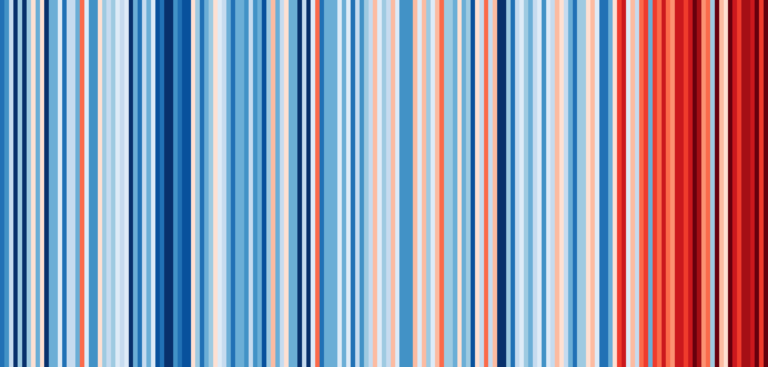Cities across the UK reported their warmest year on record in 2022 as temperatures continue to rise rapidly, according to new graphics released by the University of Reading.
The latest versions of the climate stripes graphics show the change in temperature in the UK over the past 100+ years. Shades of blue indicate cooler-than-average years, while red shows years that were hotter than average.
A new dark red bar has been added to the UK’s climate stripes graphic after it experienced its warmest year on record in 2022. Graphics for individual cities have been made available for the first time ahead of Earth Day 2023 (April 22). Previously, stripes were only available for the UK’s four nations and Berkshire, Durham, Oxford and Jersey. Now, graphics for 13 cities (Birmingham, Bristol, Cardiff, Coventry, Edinburgh, Glasgow, Hull, Leeds, Leicester, Liverpool, London, Manchester, and Sheffield) have been released.
Professor Ed Hawkins, climate scientist at the University of Reading and National Centre for Atmospheric Science, and creator of the climate stripes graphics, said, “We wanted to create these very localized stripes to give people an indication of how things are changing right where they live. We know that different parts of the UK have different landscapes, different key industries, and different population sizes – and all of this can have an impact both on emissions, and average temperatures.
“Our key observation is that regardless of all these factors, the trend remains the same – most of the more recent years have been a lot warmer than most of the years a century ago.
“After the dangerous heatwaves we experienced last summer, I hope this new city data will serve as a reminder of the very-real impact rising temperatures are having on our lives and inspire people up and down the country to play their part in helping our communities avoid the worst possible impacts of climate change.”
New graphics for every country around the world have also been unveiled and now include data from before 1900 via the Berkeley Earth project.
Stripes are available to view and download for cities, countries, continents and the globe at the showyourstripes.info website.
Using data from the Met Office, the University of Reading has also partnered up with UK charity Carbon Copy to produce stripes for individual UK counties. These stripes can be downloaded from the Carbon Copy website, where detailed information about emissions and local climate action plans is also available.
Ric Casale, Carbon Copy co-founder, said, “We know that the effects of climate change – bigger storms, longer summer droughts and more flooding – are happening right now, right here. Climate change is no longer an abstract issue for someone else to deal with, it’s something that people in the UK can see and feel locally, where they live.”



